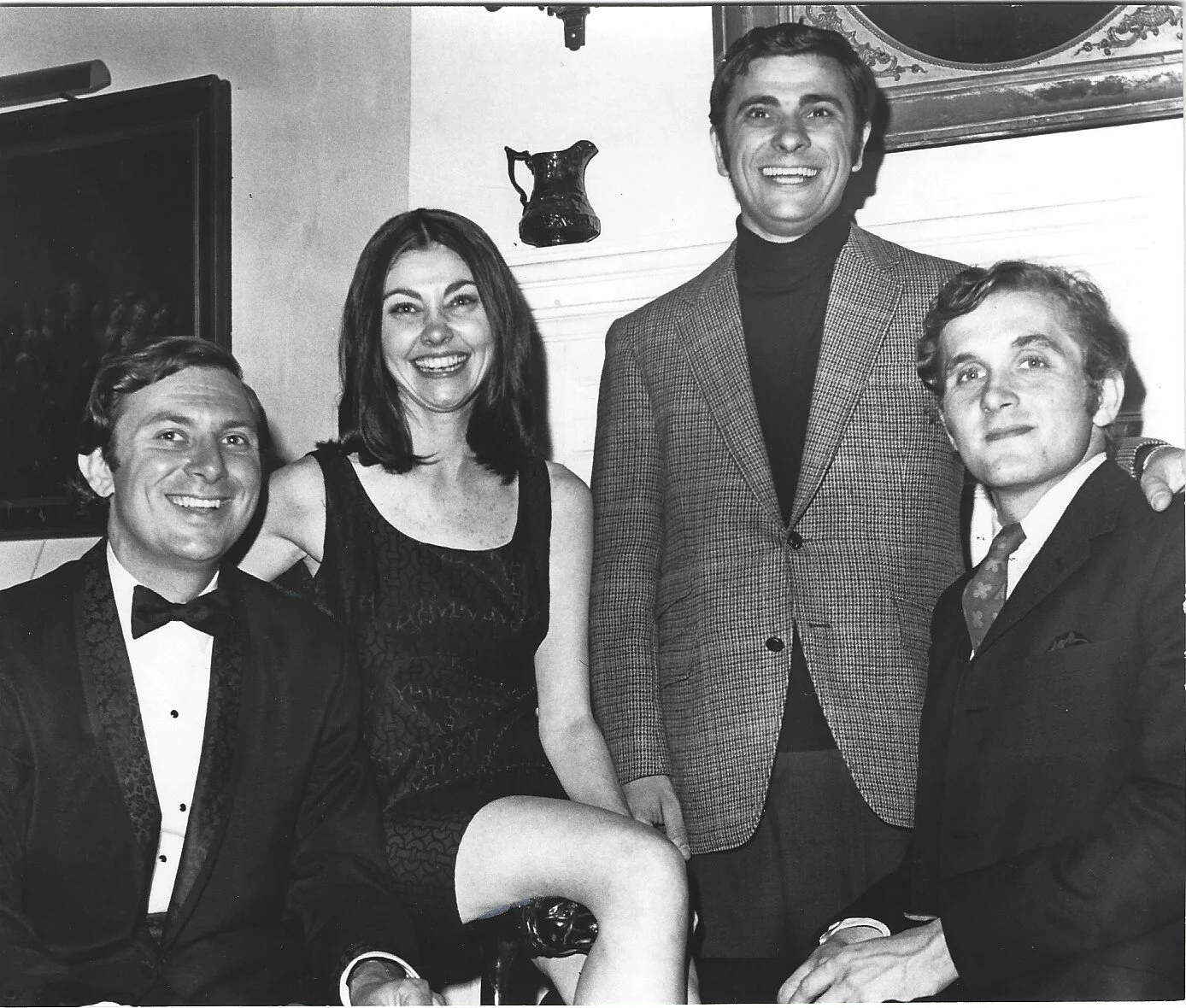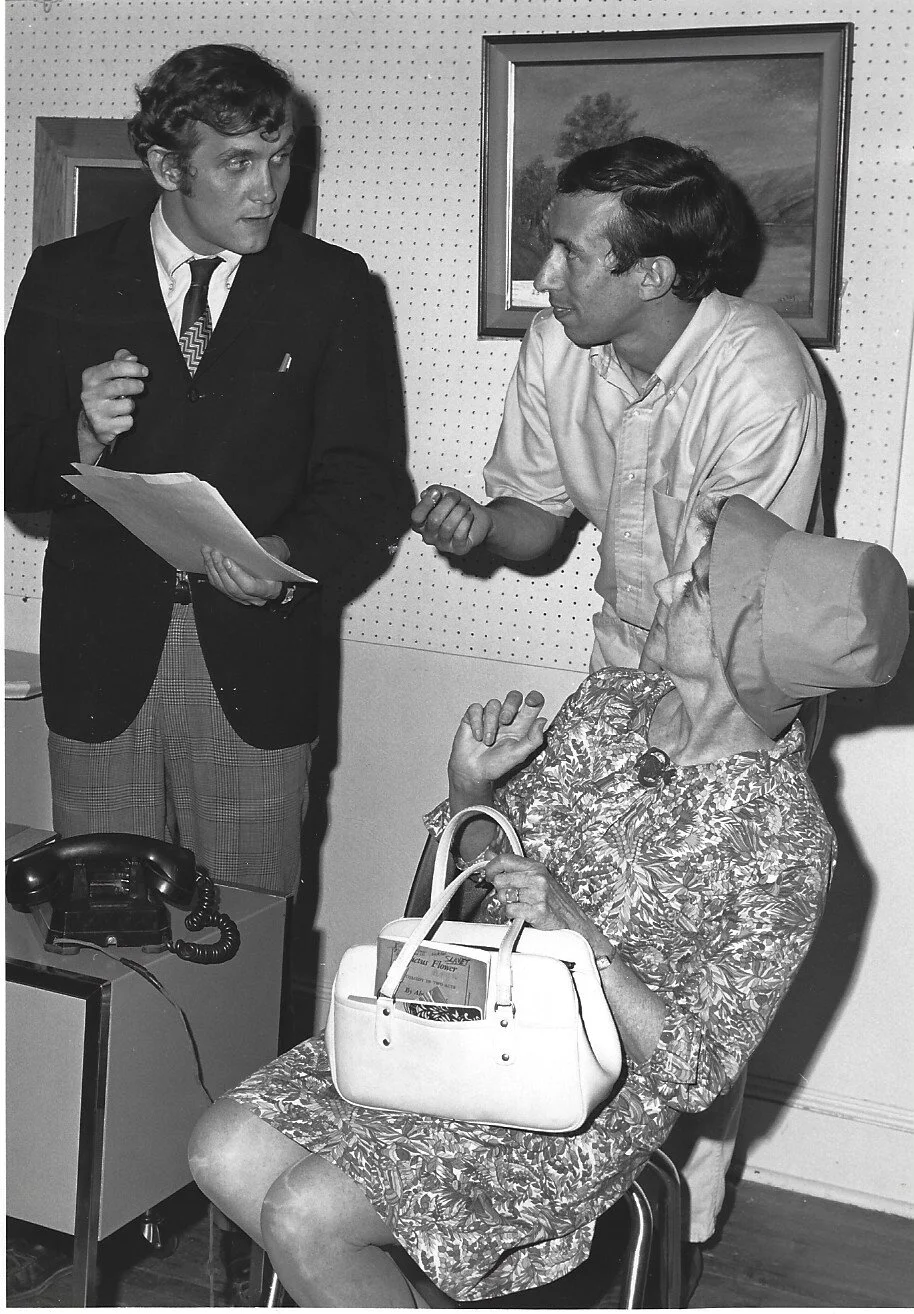Gerald Slavet: 1969
The scrapbook for the 1969 season contains clippings about the Theatre that were cut from various local newspapers, some of which are reviews of the season’s productions. There are other articles that show the many activities from managing the theatre’s daily operation to people speaking before various local civic groups, including the Women’s Club in Hagerstown, MD (Powell, L. “Gerald Slavet ….” TDM. 18 Mar. 1969). When Slavet appeared before these civic groups, he also promoted the Theatre’s youth program that included drama classes for youth as well as adults that took place after the regular summer performance season had closed (“Drama workshops ….” TDM. 11 Sept, 1969).
Early in 1969, the Old Dominion Foundation announced that the Wayside Foundation for the Arts was to receive a grant to be applied to the operating expenses of the Theatre. According to Slavet, “…. the funds will be used to help the theatre become a permanent resource in the community” by supporting the regular summer season as well as the theatre workshops and the Cinema Circus. The Foundation’s grant will allow the continued development of a school drama program in connection with the local school systems. Slavet hopes to “present two one-act plays for area school children in the fall. This program will be modeled in part after the successful program conducted by the Garrick Players in Washington, DC” (“Wayside Theatre Receives ….” TWS. 14 Mar. 1969).
The Star-Spangled Girl. June 10 - 22, 1969. Gerald Slavet, Mickey Harnett, Johnny Armen, James Scott.
For his second year at Wayside as Artistic Director, Slavet selected a season of six plays that are “fresh from Broadway and are being done for the first time in this area,” thus fitting the theme chosen for the summer, “Broadway hits Middletown” (“New Season ….” TDM. 29 May 1969). The only directing assignment for the season that Slavet took was for Who’s Afraid of Virginia Woolf? For the remaining plays, the theatre benefited from the talents of the guest directors from Arena Stage in DC, Norman Gevanthor, Alan Rafel, and Marc Weiss. In addition to directing, Rafel had been a musical director at Arena Stage, had served as pianist and singer with the University of Maryland Madrigal Singers, and composed original music for a production that had been performed at Arena Stage as well as by the Garrick Players (“ ‘The Apple Tree’….” TDM. 14 Aug. 1969). Talented actors for the season included Mickey Hartnett, who had appeared on Broadway in South Pacific, along with those with experience performing in day-time TV, such as Ronald Dawson, who had been a butler on “The Edge of Night” program for three years. Most of the season’s technical staff had credits at regional theatres, including Arena in DC and McCarter Theatre in Princeton. One local person, Marion Lewis, a veteran of many of Winchester’s Bark Mill Theater productions, was cast in Wayside’s production of Cactus Flower. This latter title was a technical nightmare as it had four sets and fifteen scenes, none of which played consecutively in the same setting!! One can imagine these scene changes on a small stage without fly area or wing space!
Despite some goofs in the 1969 season’s opening night performance of Star Spangled Girl, the play was a roaring success. For an unknown reason, the play began a half hour late. One review states that actor
James Scott as Andy Hobart, did an excellent job despite tragedy. Early in the
evening Scott received a nick in the arm when a knife came too close, and he
continued with the aid of a band-aid. At one time the glasses he was wearing fell
apart. And, at another time, the lamp he was holding seemed to come to pieces
in his hands.” Despite all this, “the actor kept his cool” (Eller. “Wayside’s ‘Star-
Spangled’ ….” NVD. 12 June 1969).
Another writer praised the comedic timing of the three actors, under the expert direction of Norman Gevanthor. He also credited the leadership of Gerald Slavet and his now defunct Garrick Players, “which drew recognition for bringing Beckett, Chekhov and Albee into the DC public schools” (Kramer, J. “Knee-Slapper ….” TWP. 12 June 1969).
The Cactus Flower. June 10 - 22, 1969. James Scott (L), Marc Weiss, Marian Lewis.
The 1969 season also included the controversial play, Who’s Afraid of Virginia Woolf? Following a 6:30 Sunday performance, a panel discussion was led by Dr. Melton F. Wright, superintendent of Frederick County Schools, Jack F. Days, executive editor of The Winchester Evening Star, Father Robert Ruth of Sacred Heart Church, Mrs. Anne Frye of Winchester, and Gerald Slavet. There is no record of what was discussed during this post-performance meeting, but one interesting fact did emerge. It was revealed that during the play’s New York run, “the four roles … were considered so emotionally and physically draining that one cast was engaged to play the evening performance, another for the matinees” (“Panel Discussion ….” TDM, 9 Aug. 1969).
The review of Arms and the Man was deemed ‘excellent’ and kudos were awarded to all members in the cast. Praise was further extended to “set designer Charles Roberts for a wood-paneled set that changes full view before the audience, from a bedroom to a garden to a library” (Campbell. “Latest Production at ….” WES. 9 July 1969).
In all the reviews of the 1969 season’s productions found to date, there is unanimity among them in awarding high marks for the high quality of acting and directing. One writer states that Wayside “brings its 1969 summer season to a close with this production of The Apple Tree and I can’t think of a more optimistic note upon which to close” (Campbell. “A Review.” TWaS. 21 Aug. 1969). Another called this production …
the most refreshing bit of theatre I’ve seen this season. The music is uniquely interpreted, the lighting effects outstanding; and the directing by Alan Rafel, done
with a deft, satiric touch, mixed with a great amount of humor. It has the bright
touch of today and leaves one with that bubbly, warm, happy glow only left after
a glass of good champagne. It is delightful! (Powell, L. “The Apple Tree ….” TDM.
25 Aug. 1969).
It was obvious that this play topped off a very successful season!
Arms and the Man. July 8 - 20, 1969. James Scott, Mickey Hartnett.
The best news of all was that Slavet announced Wayside’s 1969 season as “one of the most successful summer season in its seven year history.” Complete office records were kept during that season, and numbers for attendance could now be accurately compared. According to Slavet, the opening show, The Star-Spangled Girl, ran at 61% capacity compared to the opening show the previous year, which ran at 30%. The second show of the 1969 season, Cactus Flower, ran at 70% capacity. At the end of the first six weeks this (1969) summer, “Wayside Theatre was operating at 59.59% capacity as compared with 33.78% in 1968” with a gross of little more than double (“Wayside Theatre has Best ….” TWaS. 28 Aug. 1969).
The Theatre also ran a survey to evaluate the composition of its audience. The results of the survey were most interesting and will serve as guidelines for publicity in the 1970 season. “Audiences primarily came from nearby communities of Winchester and Front Royal. Occupations were professionally oriented or were housewives. Out of a selection of symphony, jazz concerts, ballets, films and football the most frequently attended activity was football” (“Wayside Theatre has Best …. ” 28 Aug. 1969).
And, to keep area residents abreast of activities that took place at the Theatre other than performances, there was a full-page spread in the Winchester Star that highlighted them. These behind the scenes activities included “sewing costumes, acting, compiling surveys, statistics, ushering, distributing posters, participating in panel discussions” (“Wayside Apprentices Aid ….” WES. 12 Sept. 1969). The brief text describing these activities is enhanced with seven photographs featuring actors, interns, and people from the surrounding area.
On a totally non-theatre note, the 1969 Playbill contained a photograph of Middletown’s Monroe College building along with some information about the school. It is “a two-year junior college with offerings in Business Administration, Computer Technology, Engineering Technology and Secretarial Studies” (Wayside Playbill, 1969). Additional information about the school is found in a publication printed by the Wayside Inn that contains a photograph of the graduating class and states,
Monroe College, situated in historic Middletown Virginia … has just finished con-
struction of its first building in a long range building project that is scheduled
for completion in 1975. Mason Hall is a colonial Williamsburg style building with
nine classrooms; it has colorful curtains at all windows, wall-to-wall carpeting, and colored tile baths and fixtures. The long range program … calls for two new dormitory complexes … each one is to house one hundred students …. In the academic area,
there are plans for a separate computer center and a library to house 25,000 volumes … (Wayside Inn-Quirer).
Despite high hopes for the college, not all of its plans were fulfilled. The building for the school remains in Middletown and now serves as the Campus for the Rappahannock Regional Criminal Justice Academy.


